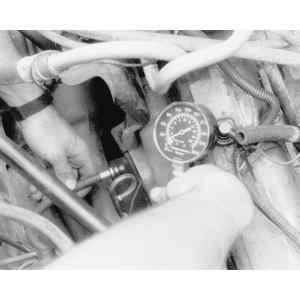A noticeable lack of engine power, excessive oil consumption and/or poor fuel
mileage measured over an extended period are all indicators of internal engine
wear. Worn piston rings, scored or worn cylinder bores, blown head gaskets,
sticking or burnt valves, and worn valve seats are all possible culprits. A
check of each cylinder's compression will help locate the problem.
NOTE: A screw-in type compression gauge is more accurate than
the type you simply hold against the spark plug hole. Although it takes slightly
longer to use, it's worth the effort to obtain a more accurate reading.
- Make sure that the proper amount and viscosity of engine oil is in the crankcase,
then ensure the battery is fully charged.
- Warm-up the engine to normal operating temperature, then shut the engine OFF.
- Disable the ignition system.
- Label and disconnect all of the spark plug wires from the plugs.
- Thoroughly clean the cylinder head area around the spark plug ports, then
remove the spark plugs.
- Set the throttle plate to the fully open (wide-open throttle) position.
You can block the accelerator linkage open for this, or you can have an assistant
fully depress the accelerator pedal.
| Fig. 1: A screw-in type compression gauge is more
accurate and easier to use without an assistant

|
- Install a screw-in type compression gauge into the No. 1 spark plug hole
until the fitting is snug.
WARNING
Be careful not to crossthread the spark plug hole.
- According to the tool manufacturer's instructions, connect a remote starting
switch to the starting circuit.
- With the ignition switch in the OFF position, use the remote
starting switch to crank the engine through at least five compression strokes
(approximately 5 seconds of cranking) and record the highest reading on the
gauge.
- Repeat the test on each cylinder, cranking the engine approximately the
same number of compression strokes and/or time as the first.
- Compare the highest readings from each cylinder to that of the others. The
indicated compression pressures are considered within specifications if the
lowest reading cylinder is within 75 percent of the pressure recorded for
the highest reading cylinder. For example, if your highest reading cylinder
pressure was 150 psi (1034 kPa), then 75 percent of that would be 113 psi
(779 kPa). So the lowest reading cylinder should be no less than 113 psi (779
kPa).
- If a cylinder exhibits an unusually low compression reading, pour a tablespoon
of clean engine oil into the cylinder through the spark plug hole and repeat
the compression test. If the compression rises after adding oil, it means
that the cylinder's piston rings and/or cylinder bore are damaged or worn.
If the pressure remains low, the valves may not be seating properly (a valve
job is needed), or the head gasket may be blown near that cylinder. If compression
in any two adjacent cylinders is low, and if the addition of oil doesn't help
raise compression, there is leakage past the head gasket. Oil and coolant
in the combustion chamber, combined with blue or constant white smoke from
the tailpipe, are symptoms of this problem. However, don't be alarmed by the
normal white smoke emitted from the tailpipe during engine warm-up or from
cold weather driving. There may be evidence of water droplets on the engine
dipstick and/or oil droplets in the cooling system if a head gasket is blown.



